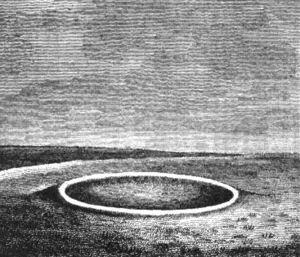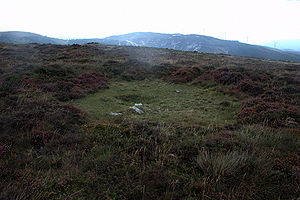
Pond barrow
Encyclopedia


In the barrow's centre there is generally a pit or shaft, sometimes containing a burial, sometimes of great depth. The barrows range from 5m to 30m (16.5 - 100 ft) in diameter. They are usually difficult to recognise, as time has rendered them less and less visible.
History of the pond barrow
It is generally agreed that the pond barrows were mainly built during the middle of the second millennium BC, mostly in WiltshireWiltshire
Wiltshire is a ceremonial county in South West England. It is landlocked and borders the counties of Dorset, Somerset, Hampshire, Gloucestershire, Oxfordshire and Berkshire. It contains the unitary authority of Swindon and covers...
and Dorset
Dorset
Dorset , is a county in South West England on the English Channel coast. The county town is Dorchester which is situated in the south. The Hampshire towns of Bournemouth and Christchurch joined the county with the reorganisation of local government in 1974...
.
They were first defined by Sir Richard Colt Hoare
Richard Colt Hoare
Sir Richard Colt Hoare, 2nd Baronet FRS was an English antiquarian, archaeologist, artist, and traveller of the 18th and 19th centuries, the first major figure in the detailed study of the history of his home county, Wiltshire.-Career:Hoare was descended from Sir Richard Hoare, Lord Mayor of...
in 1810 in a book regarding the ancient history of south Wiltshire, but they were first excavated by William Stukeley
William Stukeley
William Stukeley FRS, FRCP, FSA was an English antiquarian who pioneered the archaeological investigation of the prehistoric monuments of Stonehenge and Avebury, work for which he has been remembered as "probably... the most important of the early forerunners of the discipline of archaeology"...
earlier. The term, however, was invented by Hoare, although "barrow" refers to a hill and so this is a fairly misleading term.
Uses
The fact that only small amounts of human remains are found in the barrows suggests that they may have been used as ceremonial focuses rather than graves, and that mortuary rituals may have been carried out with them. Other possible uses include wells, for communications with the underworldUnderworld
The Underworld is a region which is thought to be under the surface of the earth in some religions and in mythologies. It could be a place where the souls of the recently departed go, and in some traditions it is identified with Hell or the realm of death...
and for dancing in.

